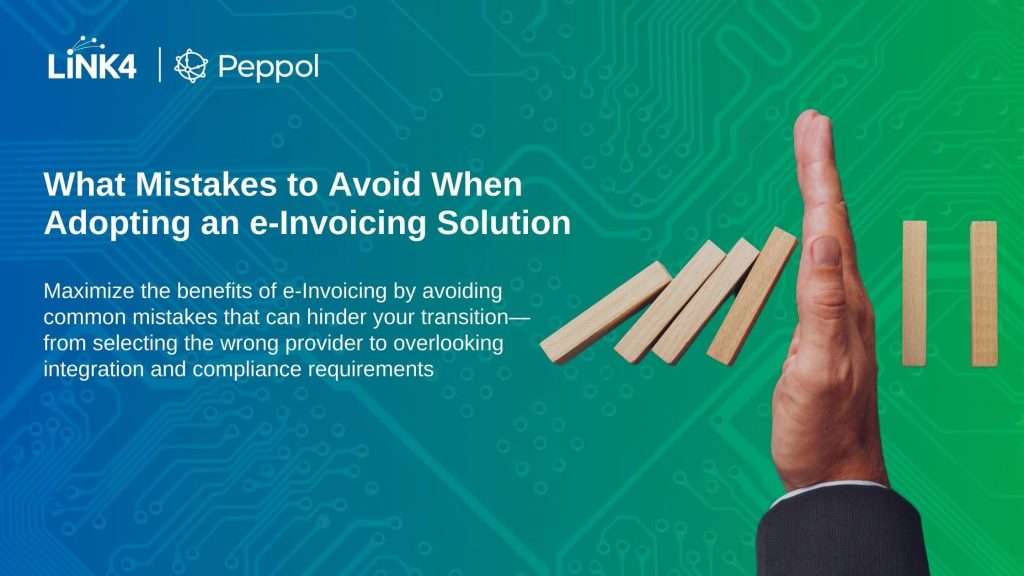
The transition to e-Invoicing is a significant step forward for businesses of all sizes. By automating the invoicing process, companies can achieve faster payments, greater accuracy, and improved efficiency. However, the path to successful e-Invoicing adoption is not without potential pitfalls. Avoiding these common mistakes can help businesses maximize the benefits of their investment.
Choosing the Wrong Solution Provider
Not all e-Invoicing solutions are created equal. Some companies make the mistake of opting for providers that lack robust integration capabilities or fail to support interoperability. Selecting a provider without understanding their ability to support cross-border invoicing or integrate with existing ERP systems can limit the scalability of the solution. Australia and New Zealand have also adopted the Peppol PINT system, an enhancement of the Peppol BIS 3.0 standard. PINT enables businesses to meet the tax and business requirements of both the sender and recipient’s countries, offering an advanced framework for international invoicing. This global standardisation helps businesses seamlessly exchange invoices across borders while accommodating local requirements.
Overlooking Mandate Compliance
One of the most frequent missteps is failing to understand and comply with e-Invoicing mandates. Many governments, such as Malaysia’s Inland Revenue Board (LHDN), are implementing frameworks to standardise e-Invoicing processes. Malaysia’s e-Invoicing mandates aim to streamline invoicing, making it crucial for businesses to prepare in advance. Similarly, while Singapore’s InvoiceNow initiative operates on a voluntary basis, it has gained traction for facilitating seamless invoice exchanges. A lack of compliance or understanding of regional requirements can lead to missed opportunities to work with government agencies and larger enterprises.
Neglecting ERP Integration
Failing to integrate the e-Invoicing solution with existing ERP systems is another common mistake. ERP integration ensures that invoices flow directly into accounting systems without requiring manual intervention, reducing the risk of errors and saving time. Businesses that neglect this step often face inefficiencies, such as having to reconcile data manually, leading to operational delays. An e-Invoicing provider should offer seamless ERP compatibility to unlock the full potential of automation.
Neglecting Internal Readiness
Another common mistake is underestimating the importance of internal preparation. Transitioning to e-Invoicing isn’t just about implementing new software; it’s about ensuring your team is ready for the change. Companies should provide adequate training and clear communication to employees who will be using the system. Failure to do so may result in resistance to adoption, operational inefficiencies, or a poor return on investment.
Focusing Solely on Cost
While budget considerations are important, focusing solely on cost is a mistake that can compromise long-term success. A cheaper solution might lack essential features like integration with ERP systems or compliance with regional mandates. Businesses should look beyond initial costs and consider the solution’s total value. Features such as automation, error reduction, and real-time data exchange can lead to significant savings and improved cash flow over time.
Ignoring Supplier Readiness
Adopting e-Invoicing is not a standalone activity. Businesses must also ensure their suppliers are ready to embrace the technology. Companies often overlook this step, leading to delays or gaps in the invoicing process. Early engagement with suppliers and partners can smooth the transition. A framework’s interoperable design, such as the Peppol network, is particularly useful in addressing this challenge, as it ensures seamless communication between businesses regardless of their internal systems. For example, Australia’s growing adoption of Peppol has enhanced collaboration across industries, fostering a more connected business ecosystem.
Failing to Address Security Concerns
Security should never be an afterthought when adopting an e-Invoicing solution. Mishandling sensitive financial data can lead to breaches, reputational damage, and regulatory penalties. Businesses should choose a provider that prioritises security, such as encryption protocols, secure access controls, and compliance with local and international data protection laws. Secure platforms are designed with these concerns in mind, offering a reliable foundation for exchanging invoices.
Overcomplicating the Implementation
Adopting an e-Invoicing solution doesn’t have to be a complex or drawn-out process. However, businesses sometimes overcomplicate the implementation by trying to customise too many aspects of the solution. While flexibility is important, over-customisation can lead to delays, increased costs, and inefficiencies. Starting with a straightforward approach and scaling as needed is often the better strategy. Standardised frameworks, such as those supported by the Peppol network, minimise these challenges by offering a simple yet effective foundation for businesses to build upon.
Failing to Measure Success
Lastly, many companies fail to define clear metrics for success before implementing e-Invoicing. Without benchmarks, it becomes difficult to assess whether the solution is delivering value. Key indicators such as reduced processing times, faster payment cycles, and lower error rates should be established from the outset. Regularly reviewing these metrics will help businesses fine-tune their approach and maximise the benefits of their e-Invoicing investment.By avoiding these common mistakes, companies can ensure a smooth transition to e-Invoicing and unlock its full potential.
Find out more on how you can integrate your e-Invoicing solution with Link4: https://link4.asia/my
Find out more about e-Invoicing
- Link4 Strengthens Its Regional Presence with New Sales Leaders Across Asia
- Peppol, decoded: What Malaysian Businesses Need to Know Before Choosing a Service Provider
- Link4 Expands Asian Footprint with New Colombo Office
- What Malaysian Businesses Still Get Wrong About e-Invoicing
- Everyone’s Talking About the e-Invoicing Mandate. But No One’s Talking About What Comes After.
Footnote: In this article, “e-invoicing” is used interchangeably to refer to electronic invoicing.